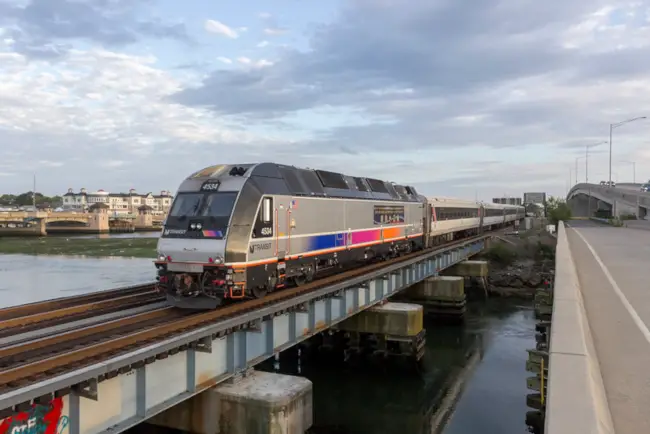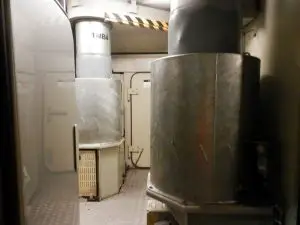Background
Unveiled at Germany’s Innotrans in 2010, the ALP-45DP was the latest product from Bombardier for the American market. It boasted a dual powered design that allowed the locomotive to operate under diesel power, or collect electric power from overhead catenary wire. This locomotive demonstrated flexibility and convenience for their owners, and have improved the efficiency of operations. To date, there are fifty-five examples of this locomotive built for both NJ Transit and AMT, with NJ Transit ordering another 17 units, due for delivery in November 2019.
With New Jersey Transit’s various rail lines spanning electrified and non-electrified territory, a dual mode locomotive was needed. After careful consideration of which company to contract the work to, Bombardier in Germany was ultimately chosen. Twenty-six ALP-45DPs were ordered by NJ Transit in 2008, and two years later, the railroad made an additional order of 9. These locomotives were slated to replace most of their fleet of F40PH-2CAT’s and GP40PH-2s, which were rebuilt in the late 1980s. By 2012, the ALP-45DP locomotives could be seen operating on all NJ Transit rail lines throughout the state, especially the North Jersey Coast Line, and Raritan Valley Lines.

The purpose of the ALP-45DP was to provide passengers with through service without changing trains due to the lack of overhead wiring. For example, NJ Transit now provides one seat service from Bay Head to New York Penn Station without the need to switch trains at Long Branch, NJ. Also, as of March 2014, direct rail service to New York Penn Station was also established on the Raritan Valley Line, thus, opening another opportunity to demonstrate the flexibility of the locomotive.
This is not a newly introduced concept, as other rail lines in North America use dual powered locomotives. A prime example of this would be Amtrak and Metro-North’s P32-ACDM locomotives, which are part of the GE Genesis lineup. These locomotives retain their diesel prime mover, with the addition of electrical pickup from a third rail, primarily for use in Grand Central Terminal.
Montreal’s Agence Metropolitaine de Transport (AMT) purchased 20 locomotives to replace their GMD GP9u locomotives, as well as the locomotives they had on lease. AMT is a commuter railroad that operates service within the Quebec province, primarily serving Montreal and the surrounding areas. The AMT ALP-45DPs are numbered 1350-1369, and cost the railroad $172,716,536 U.S. dollars to produce. AMT ordered these in anticipation of using them on their Mascouche line, in which the locomotives will run under the wires. Currently, they are solely used in diesel operation on the AMT.

Design and Technical Information
The engineers that built the ALP-45DP studied the ALP46 locomotive previously ordered by NJ Transit, and the European TRAXX locomotive, which is used in both passenger and freight service. ALP-45DP, stands for “A=American, L=locomotive,P=passenger, the 45 being how much power output the locomotive produces, and DP= dual power.
The ALP series of locomotives was derived from the European TRAXX locomotives, that provide both diesel and electric traction. The similarities between the TRAXX locomotives and the ALP locomotives is evident, as they have a similar carbody design and cab layout.
The construction of the ALP-45DP had to be lightweight and versatile. For this design to be successful, the weight was to be kept below 288,000 pounds. This posed as a challenge to Bombardier, as this locomotive was dual mode, and required more equipment within the carbody. In addition, clearances within the Hudson River Tunnels limited the height of the locomotive to 14′ 6”.
When choosing a diesel prime mover for the locomotive, it was important to meet these weight and height requirements. The decision was ultimately made to equip the locomotives with two Caterpillar 3512C HD diesel engines, which were designed for high speed operation. These engines had 12 cylinders, and each produced 2,100 horsepower. These engines operate separately, so each engine received its own 900 gallon fuel tank which retained a unique design, as each engine had two fuel tanks, carrying roughly 400 gallons each. Under diesel power, the two Caterpillar prime movers power a MITRAC TG 3800 A alternator that generates 1700 kVA @ 1800RPM. In diesel mode, the two prime movers together create 4,200 hp, and is capable of pulling an 8 car train. Under electric power, the locomotive generates 6,700hp. Manufactured by Transtech, the pantograph used generates power to the traction motors through two MITRAC TC 3360 DP converters.
When choosing which prime mover to utilize,with weight being a significant factor, a number of prime movers were considered. One of which was the EMD 710 prime mover, which could be accommodated within the carbody, however, the cooling system would be difficult to install due to the need to also house the transformer for electric power. These factors considered, they decided on the caterpillar prime movers, which were assembled by Caterpillar in Lafayette, Indiana. Each locomotive would be fitted with two of these prime movers, each generating up to 2,100 horsepower, while the head end power (HEP) is supplied by a converter located within the locomotive, not a separate generator.

The design of the ALP-45DP locomotive was designed based on the ALP46, due to its success and proven design. Many parts from the ALP46 were utilized, such as the pantograph and traction motors, due to their success on the Northeast Corridor, and their ability to navigate through New York Penn Station. Due to the railroad personnel’s familiarity with the ALP 46 locomotive, Bombardier designed the cab similar to the ALP 46. Due to the extra equipment inside the carbody of the locomotive, dual cabs were not possible for these units.
Yet another dilemma was the length required to fit into the maintenance pit within maintenance facilities, the locomotive had to have a minimum length of 74 feet. The engineers at Bombardier managed to construct the locomotive to be just 71.52ft.
Dual Power Ability
What makes the ALP-45DP truly unique is the dual mode capability, and its ability to be changed between power modes in just 100 seconds. This allows NJ Transit to provide a one seat ride without the need to change locomotives or passengers changing trains. This is especially significant for the one seat services into New York, the railroad’s busiest station. The locomotive was designed to provide continuous head end power to the train while power is switched between modes. When switching from electric to diesel mode, the pantograph does not drop until the diesel prime movers are activated. When it switches from diesel to electric, the diesel engines are not deactivated until the pantograph makes contact with the overhead wires.
Braking System
Braking for this locomotive is powered by Wabtec, using its Fastbrake system. This is designed to reinforce braking for high speed operation. The Fastbrake system incorporates two brakes on each axle, as well as wheel tread brakes.
Compliance with Amtrak
Because of NJ Transit’s operations over Amtrak’s Northeast Corridor, the ALP-45DPs had to meet their crash worthiness standards, such as their A-05-1355 structure gauge, as well as the CFR and AAR crash structure standards. The diesel prime movers meet the EPA Tier 3 emission standards, with further efforts ongoing to comply with tier 4 emissions.
ALP-45DP Specifications
| Wheel Configuration | B-B |
| Length | 71.52ft |
| Width | 9ft 8 1/2in |
| Axle Load | 32.65 tons |
| Weight | 130.6 tons |
| Electric Pickup | NJT: 25Hz AC Catenary AMT: 60Hz AC Catenary |
| Prime Mover | 2 Caterpillar 3512C HD Diesel Engines, turbocharged |
| Alternator | 2 MITRAC TG 3800A, 1700 kVA |
| Traction Motors | 4 MITRAC DR 3700F, 1,300kW. |
| Head end power | 1100kVA 1,000 kW producing 1,300hp. 3 phase, 3×480 V AC 60 Hz |
| MU | Capable for 2 units. |
| Braking System | WABCO Electro-pneumatic. Disk and tread brakes. |
| Max Speed | Diesel=100 mph. Electric=125mph |
| Horsepower | Diesel=3,600hp, 2,734 with HEP. Electric=5,900hp. |
| Tractive Effort | 71,000lbs starting. 59,000lbs continuous |
I had the opportunity to get up close and personal with these units while on display at Philadelphia’s 30th Street Station in 2014. I was able to view the dual caterpillar prime movers for diesel operation, and the electrical transformer for operation via the overhead catenary. I also caught a glimpse inside the cab at the control stand, and the simplicity of design. Below are some snapshots of the engine compartment, and dual prime movers of this unique locomotive.



